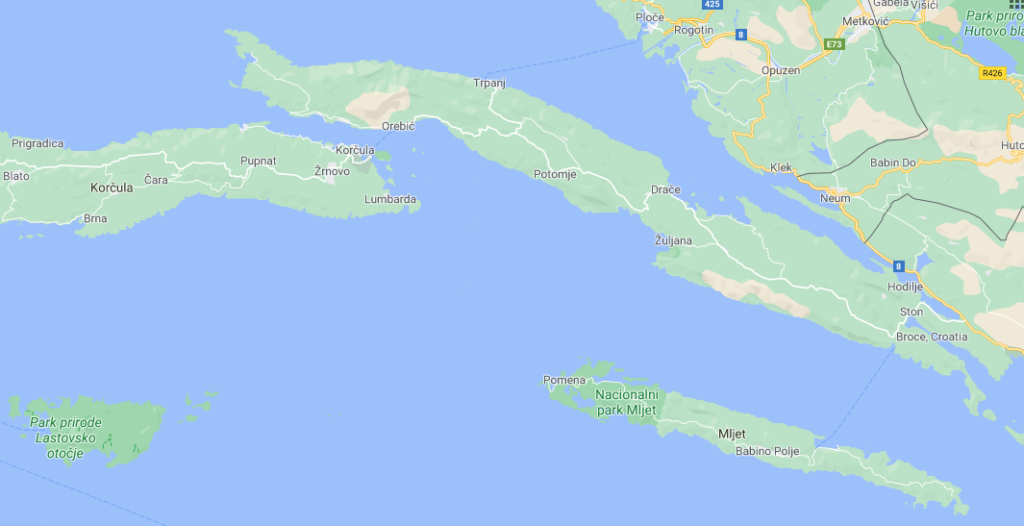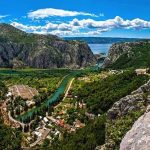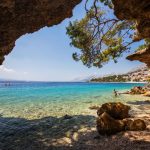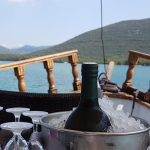The tranquil Pelješac peninsula deep in the Dalmatian south is the place to enjoy life surrounded by beautiful beaches, great food and wine, minus the crowds.
- Welcome to Pelješac!
- How to get to the Pelješac Peninsula and get around
- 5 things not to miss on Pelješac
- Where to stay?
- Where to eat?
- Top 5 day trips from the Pelješac Peninsula
- 5 things you didn’t know about Pelješac
- Festivals on the Pelješac Peninsula
Welcome to Pelješac!
Pelješac is the second largest peninsula in Croatia. Stretching its length of 77 kilometres in southern Dalmatia, it is an authentic combination of unspoiled nature, powerful red wines and amazing food, secluded beaches, lots of history, and accommodation options ranging from exclusive villas to hidden little camps.
How to get to the Pelješac Peninsula and get around
Plane
The closest international airport is Dubrovnik, a little bit over an hour from Pelješac by car. The upside is a scenic route between the two, cruising along the coastline. The downside is that during the high season, there is often a lot of traffic on the Adriatic Highway.
Road
The southernmost point of the A1 motorway connecting Zagreb with Dalmatia is the town of Ploče. From there, you have two options. The first is a short ferry ride Ploče – Trpanj, which is close to the western tip of the peninsula. The second option is driving south for an hour more, to get to Ston. Option two includes crossing the Bosnian border.
Regular bus lines connect Zagreb, Split and Dubrovnik with Pelješac. The final destination for most of those bus lines on the peninsula itself is the town of Orebić. From there, the buses take a ferry over to Korčula. Of course, there are smaller bus stops along the way on Pelješac.
Looking for a fast, reliable and trouble-free transfer to or from Pelješac? Contact TC transfer partner Adriatic Transfers for your one-stop solution.
The Pelješac Bridge
One of the biggest infrastructure projects in Croatia currently is the construction of the Pelješac Bridge. Once it’s finished, it will connect the Dubrovnik region with the rest of Croatia. That will result in reduced travel times to and from Dubrovnik, but also to the islands of Mljet and Korčula. You can read more about the project on TCN’s dedicated page. Likewise, you can check the webcam, to see what’s happening right now!
Boat
A ferry line connects the mainland town of Ploče with Trpanj on the northwestern side of the peninsula. You can find the schedule for the ferries on this link (opens a .pdf document). Orebić, the largest town in Pelješac, lies directly across the island of Korčula. From there, it only takes 15 minutes by ferry to reach the island. You can find the schedule for the Korčula – Orebić ferry on this link (opens a .pdf document). For those on foot, there is also a regular boat line from Orebić to the centre of Korčula. There are some administrative issues with the boat line this year, so here’s the link to last year’s schedule (it really doesn’t change much). On the south-eastern end of the peninsula, from the bay of Prapratno you can catch a ferry to the island of Mljet (link to the schedule).
5 things not to miss on Pelješac
Taste the local wines – Plavac Mali
Some of the most famous Croatian wines come from Pelješac. They are made from the iconic Plavac Mali grape, giving big, powerful reds. A lot of Croatian wine experts believe that Plavac from the slopes of Dingač and Postup are among the best wines in Croatia. These two legendary appellations were the first Croatian wines with protected designation of origin, back in the 1960s. Find out more about the variety in the Total Croatia Wine article.
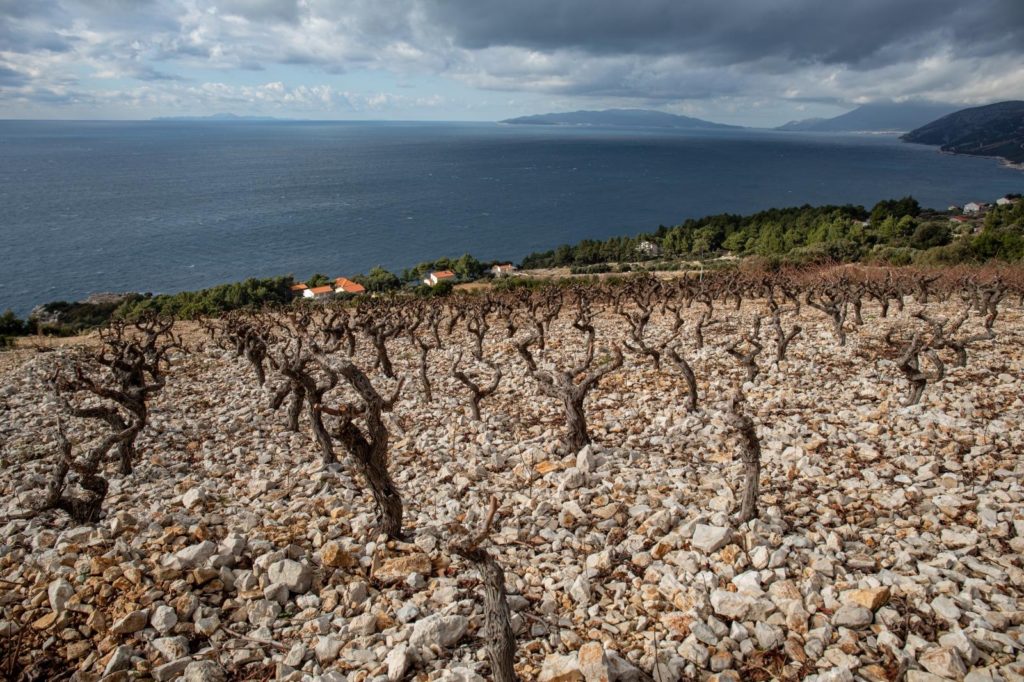
Spare a few hours to do a thorough tasting at one or more of the notable wineries, like Miloš, Bura, Kiridžija, Matuško, Bartulović… You can also turn it into a fine dining and pairing experience at an exclusive place like Korta Katarina or Saints Hills. Or stop by the laid-back Peninsula wine bar & shop to try wines from more producers and stock up on what you like.
Climb the Walls of Ston
The little town of Ston, closest to the mainland, is full of history. In the Middle Ages it flourished under the Dubrovnik Republic. The site of the oldest saltworks in Europe, it was defended by long fortification walls built in the 14th century. These days you can walk the remaining 5.5 kilometers of this complex architectural feat, with 40 towers and 5 forts.
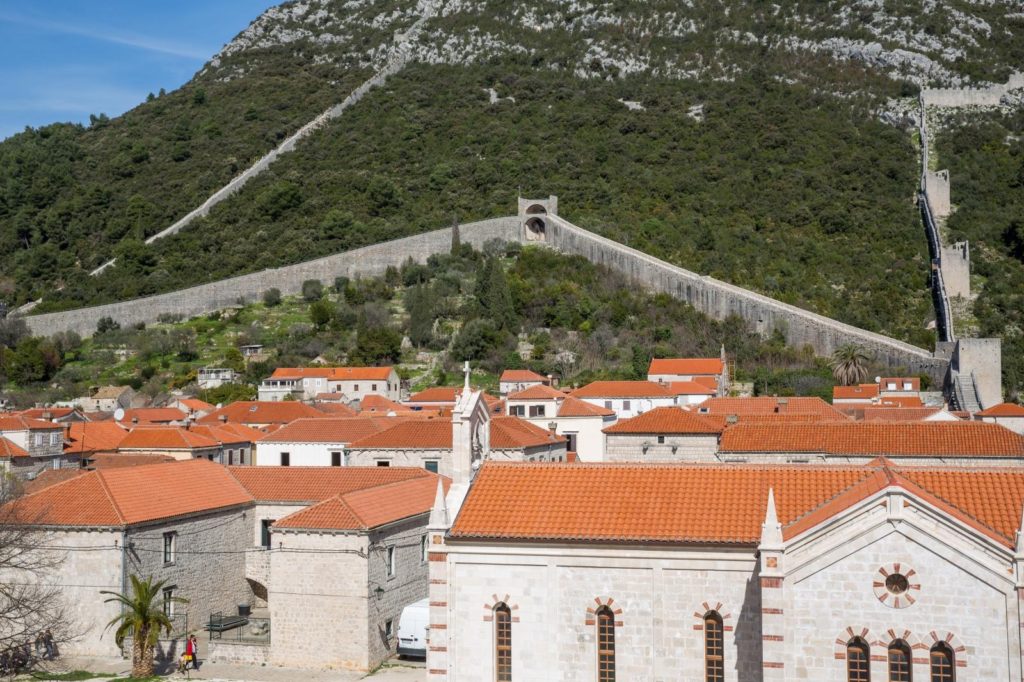
Including the time for enjoying the view and taking photos, the whole tour takes about an hour. Keep in mind that during the hottest period of the year, you will not be able to make the climb mid-day, rather only during the morning and evening hours. In addition to the walls, make sure you have some oysters in Ston, and buy some salt, directly where it’s produced using the most traditional technique there is – by letting the seawater evaporate under the summer sun!
Marvel the view from Sveti Ilija
Pelješac is dominated by a mountain stretching along the peninsula, called Zmijsko brdo or the Snake Mountain. Its highest peak is Sveti Ilija (961 m) and it’s an amazing opportunity for experienced and well-prepared hikers to climb the top. On the other hand, the rest of us on our vacation can visit the church and cemetery Our Lady of Angels to take in the marvelous view. Located above Orebić, this 16th-century Franciscan monastery is a wonderful spot for meditation, with the panorama of the Strait of Pelješac and Korčula in front of you.
Explore the beaches
As there are no bigger towns or touristy resorts, the crowds on Pelješac are never really a problem. That is to say that Pelješac is perfect for beach hopping. All along the coast, there are numerous bays, coves, and hidden beaches, mostly pebbly and a few sandy. For instance, Žuljana, Prapratno, Divna, Jezero, Duba, Mokalo, are among the better-known ones, with many more to explore.
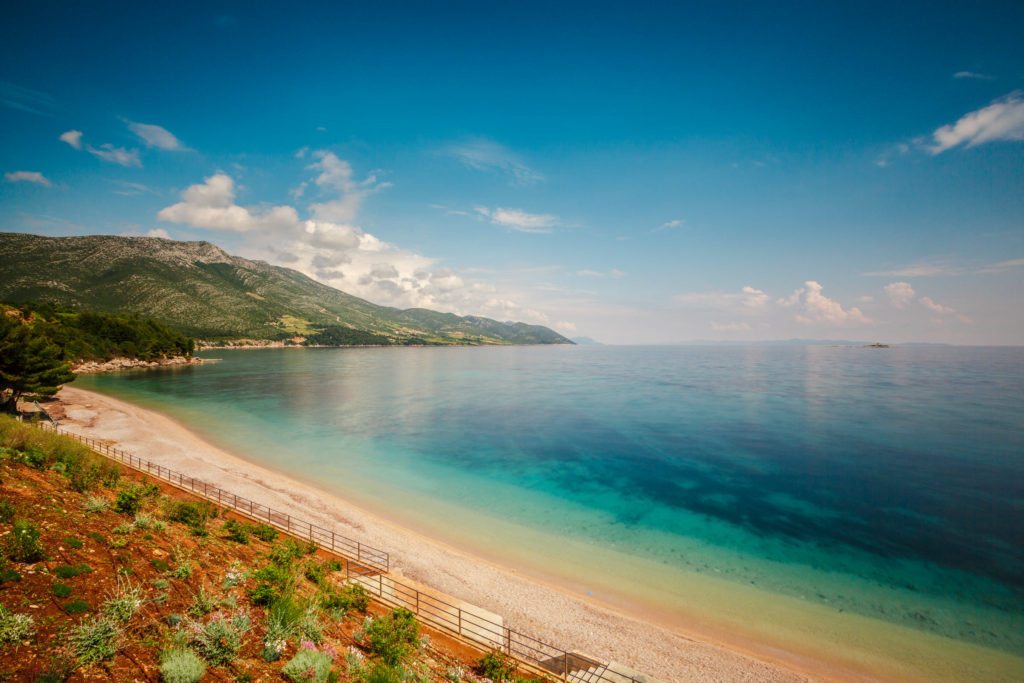
Enjoy the famous Ston oysters
The Bay of Mali Ston is the oyster center of Croatia. As oysters and mussels have been farmed here since Roman times, their fame is well-deserved. They are best slurped raw at one of the local restaurants, or directly at the farms. If you want a full experience, you can book a trip to the oyster beds, too.
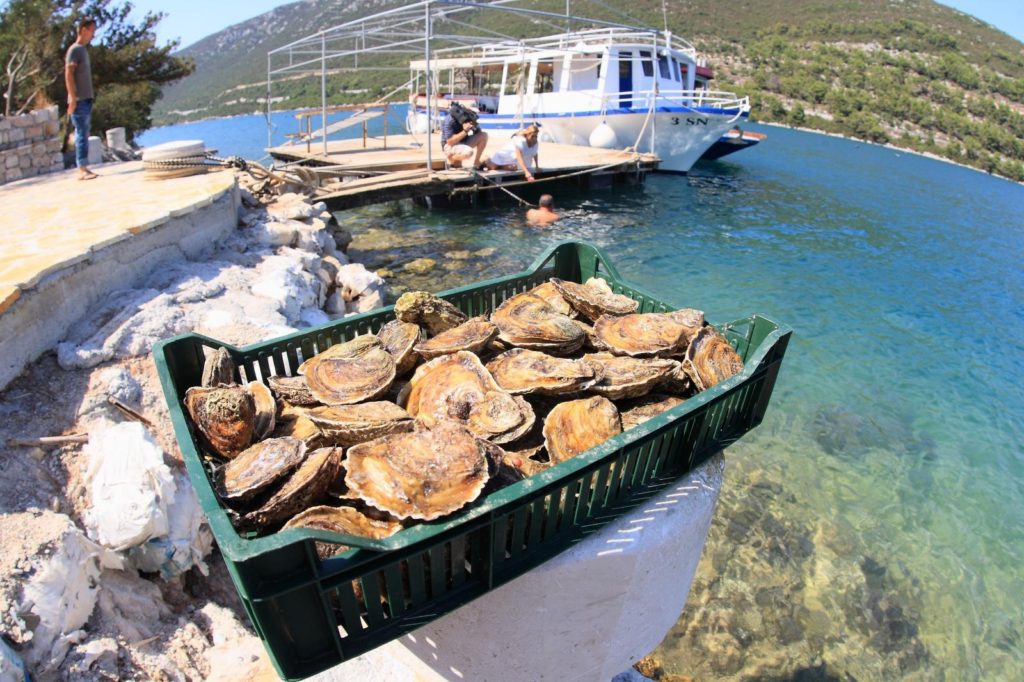
Each March, at the time when the oysters are “the best”, there is a festival of oysters organized in Mali Ston. For the fans, that is absolutely something you don’t want to miss, enjoying as many oysters as you can take, prepared in the most imaginative ways, surrounded by like-minded people and a lot of good wine.
Where to stay on Pelješac
As it is not overrun with tourism, Pelješac does not abound in large hotels or resorts. However, there are plenty of options all over the peninsula. A few of the larger hotels are located in Orebić, as well as one in Trpanj. Accommodation facilities mostly consist of private apartments and houses or villas to rent. Villa Korta Katarina & Winery is certainly the benchmark for luxury in this area.
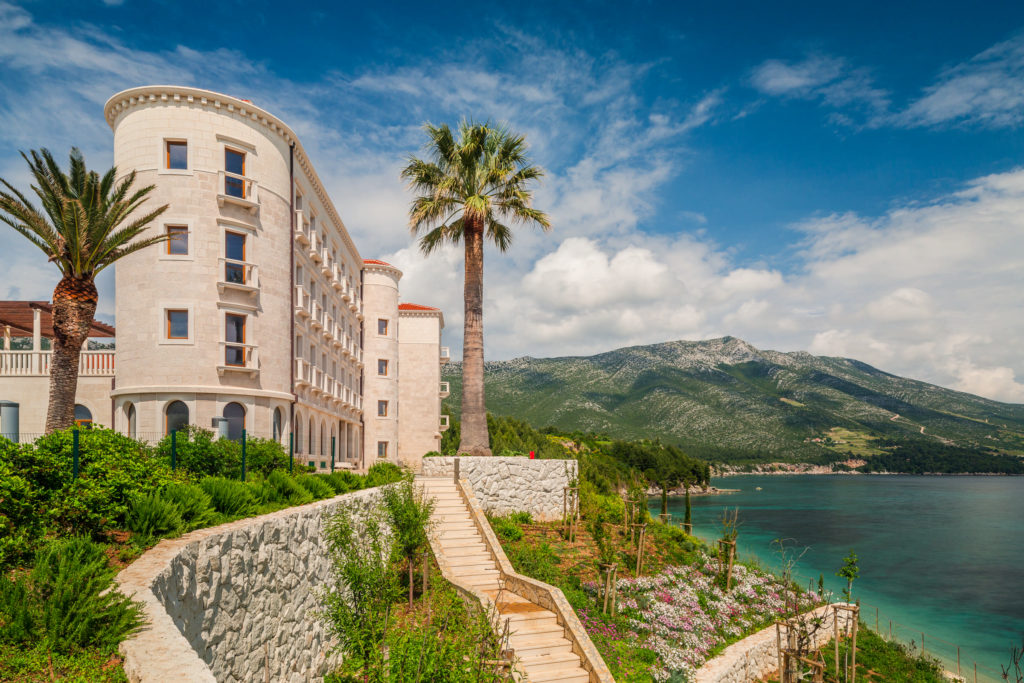
Pelješac is heaven for campers, especially if you like smaller, secluded places. There are over a dozen good quality camps on some amazing locations, like Mokalo near Orebić. Some of them also offer mobile houses or glamping units.
Where to eat in Pelješac
It is only natural that a place famous for great wines boasts excellent food as well. With the freshest seafood straight from the Adriatic and homegrown produce from local gardens, Pelješac is one of the best foodie spots in Dalmatia. As can be expected, are many classic family-run seafood restaurants with long tradition, like Bota Šare or Villa Koruna in Mali Ston, Lukas Taverna or Bakus in Ston, Stari kapetan in Orebić, or Tuna bar in Trpanj. Or, if you’re looking for an exclusive fine dining experience, go to the Saints Hills and Korta Katarina wineries.
For a more off-the-beaten-path experience, head to one of the rural inns in small inland villages, like Antunović in Kuna, Domanoeta in Janjina, or Panorama near Orebić. Croccantino, a small café and pastry shop next to the ferry port in Orebić will amaze you with their homemade cakes and ice cream. In addition, keep one thing in mind: if you ever come across Stonska torta (Ston cake), try this unusual traditional dessert made with pasta, nuts, and chocolate.
Top 4 day trips from the Pelješac Peninsula
Dubrovnik
People usually go to Dubrovnik and do a field trip to Pelješac from there. Why not do the opposite – stay in the peaceful Pelješac and spare a day to visit the world-famous Pearl of the Adriatic. The distance is about an hour and a half by car. If you’re not sure if Dubrovnik is worth a visit, we have an article that will convince you not to miss it. Furthermore, local travel agencies also offer day-trips to Dubrovnik.
Korčula
Literally across the Strait of Pelješac, 15 minutes by ferry from Orebić, the island of Korčula is a must-visit. Take a stroll through the beautiful old town of Korčula. Explore its narrow medieval alleys and numerous historic buildings. Sit down on a terrace by the town walls, experience the unique local cuisine and indigenous wines. If you can, catch the traditional Moreška sword dance show. Visit Lumbarda and its amazing beaches (and taste the Grk wine, while you’re there, as the fields in Lumbarda are the only location where the grape was traditionally grown). Go further inland, visit Pupnat and its Michelin-recommended restaurant Konoba Mate – and that’s not the only Michelin-decorated restaurant on the island!
Mljet
Mljet, part of which is a national park, is one of the most enchanting Adriatic islands. Shrouded in a lush forest, tranquil and pristine, it’s a piece of Mediterranean heaven. There is so much to see and do on Mljet, but the lakes (and an islet on the lake on the islet..) are probably the biggest attraction. A must-visit for nature lovers, the ferry ride to Mljet from Prapratno near Ston takes an hour and 20 minutes. There are also boat day-trips which travel agencies on Pelješac (and Korčula) offer.
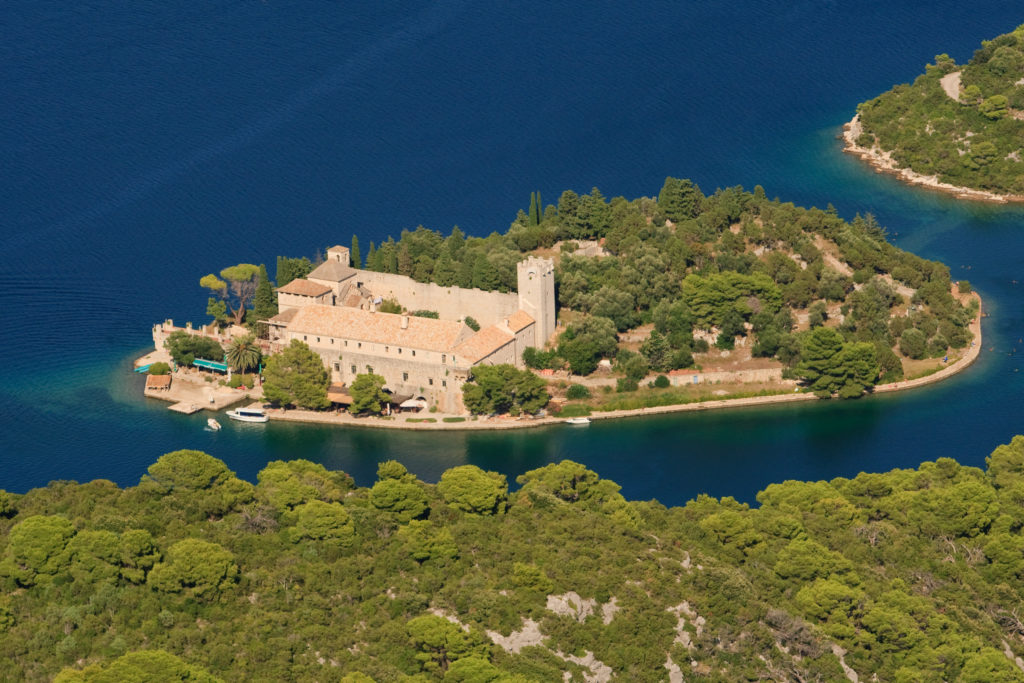
Neretva Valley
The green and fertile delta of the Neretva River is full of rich wildlife, as well as historical sites. The ferry from Trpanj takes you to the port town of Ploče, the gateway to Neretva. Once you’re there, a safari boat tour is the best way to experience the river. Make a stop at a rural inn to taste their homemade dishes, especially the frog and eel brodetto. For history fans, the Natural History Museum in Metković and the nearby Narona Archaeological Museum are worth a visit.
6 things you didn’t know about Pelješac
Mike Grgich makes wine in Pelješac
The life of the legendary Croatian-American winemaker deserves a Hollywood movie. He came to California as a young man with a degree in oenology, with all he owned in a cardboard suitcase. These days, it is on display in the Smithsonian’s National Museum of American History. Grgich rose to fame as the author of the Chardonnay that beat French wines at the legendary Paris Wine Tasting of 1976. Later he founded his own winery, and the rest is history. As a native of Dalmatia, he wanted to give something back to his homeland. Therefore, in 1996 he founded a small winery in his native Pelješac, producing only two local varieties. That resulted in Pošip white and Plavac Mali red, regularly among top-quality Dalmatian wines. That is to say, a visit to the winery is truly a historic experience, and something every wine-lover will appreciate.
Pelješac inspired the art of Celestin Medović
Born in Pelješac, Celestin Medović was one of the most important Croatian painters of the late 19th and early 20th century. Schooled in Italy and Munich, he would always return to his home. Pelješac inspired a great number of groundbreaking landscapes and seascapes. Medović is burried in Kuna, and today you can find his statue and an art gallery bearing his name in this small town.
Orebić is a place of great seafaring tradition
The history of Pelješac is unseparable with its seafaring past. Orebić has the nickname “The Sea Captain’s Town”, and for a very good reason. Many mansions with lovely gardens found in the old town were built by retired sea captains. Get a glimpse of the rich local history in the Maritime Museum. It includes various artifacts, not only from the nautical era but also archaeological finds and items from everyday life.
Viganj lives for Windsurfing
The village of Viganj is one of Croatia’s windsurfing and kitesurfing hotspots. The channel between Korčula and Pelješac brings favorable winds, creating excellent conditions for catching the waves. The wind mostly to thank for that is the maestral, which is present in the channel on most summer afternoons. There are plenty of surfing schools and courses for all levels. Even if you’re not into surfing, it’s fun just to grab a drink in a beach bar and watch the action.
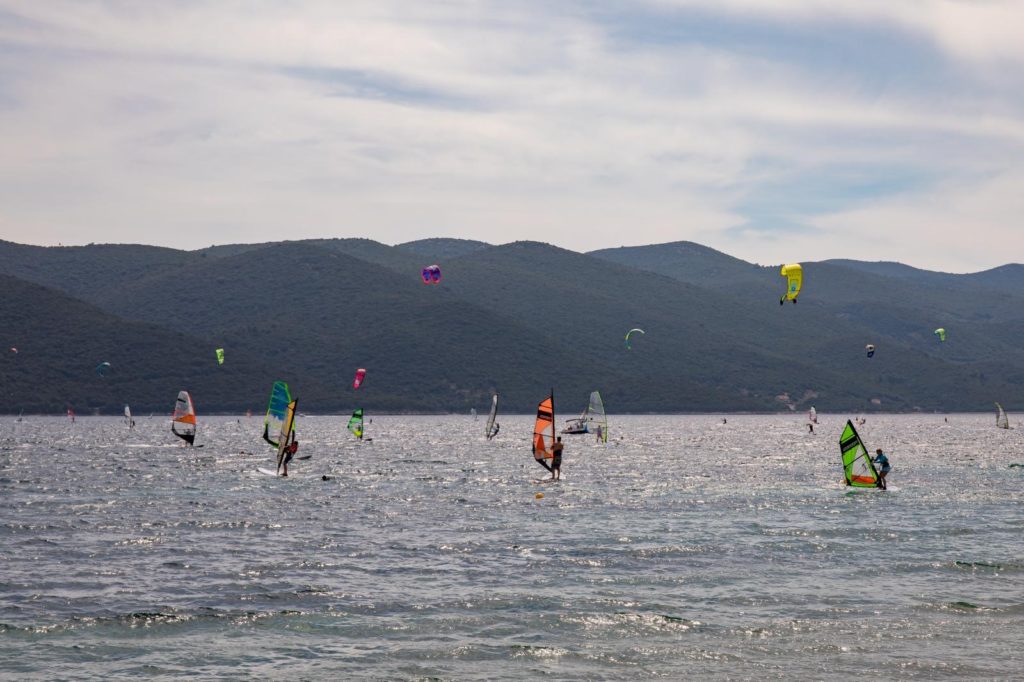
Ancient past buried deep in Nakovana
Nakovana, or Nakovanj, is probably the oldest village in Pelješac, now deserted and isolated. Yet, traces of 8,000 years of history and lots of legends surround the area. Nakovana Cave is one of the richest archaeological sites for the Illyrian culture ever discovered. Although there aren’t any facilities, consider it an ancient outdoor museum, perfect for history buffs. Or a remarkable spot for hiking and cycling. Don’t be surprised if you cross paths with some bighorn sheep roaming around.
Donkeys built the wine business of Pelješac
When you see vineyards on the steep hills overlooking the sea, you must wonder how is it possible to harvest the grapes. The answer lies in the hardworking and cheap labor force called the donkey. They are used to climbing anyway, and carrying baskets full of grapes is no big deal for these intelligent and friendly animals. No wonder there is a picture of a donkey on some of the iconic Pelješac wine labels. You can meet and greet donkeys on the Antunović family farm in Kuna Pelješka.
Festivals on the Pelješac Peninsula
Small places in interesting locations often deliver quaint festivals and events that turn out as great fun. And Pelješac is no exception. That’s why it’s good to keep an eye on the event calendar. For foodies, there are the Days of Mali Ston Oysters in March, at the peak of the oyster season. Several wine festivals take place throughout the year, like Pelješac Wine Roads in December. The Ston Wall Marathon is a unique race and an experience to remember. Salt Festival in Ston has the most beautiful venue in one of Europe’s oldest saltworks. Viganj Wind Festival is a celebration of the windsurfing lifestyle.
More information
For more updates and detailed information, visit Dubrovnik and Neretva County Tourist Board official website.
To follow the latest news from the Pelješac Peninsula, check out the dedicated TCN page.

